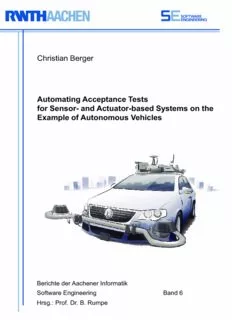Table Of ContentChristian Berger
AAuuttoommaattiinngg AAcccceeppttaannccee TTeessttss
ffoorr SSeennssoorr-- aaaannnndddd AAAAccccttttuuuuaaaattttoooorrrr--bbaasseedd SSyysstteemmss oonn tthhee
EExxaammppllee ooff AAuuttoonnoommoouuss VVeehhiicclleess
BBeerriicchhttee ddeerr AAaacchheenneerr IInnffoorrmmaattiikk
Software Engineering Band 6
Hrsg.: Prof. Dr. B. Rumpe
Automating Acceptance Tests for Sensor-
and Actuator-based Systems on the
Example of Autonomous Vehicles
VonderFakultätfürMathematik,Informatik undNaturwissenschaftender
RWTHAachenUniversityzurErlangungdesakademischenGradeseines
DoktorsderNaturwissenschaftengenehmigteDissertation
vorgelegt von
Diplom-WirtschaftsinformatikerChristianBerger
ausBraunschweig
Berichter: Universitätsprofessor Dr.rer.nat.BernhardRumpe
ProfessorDr.-Ing. ThomasForm
Tagdermündlichen Prüfung: 19.Juli2010
DieDruckfassungdieserDissertationistunterderISBN978-3-8322-9378-9erschienen.
Howeverimpenetrableitseems,ifyoudon’ttryit,thenyoucanneverdoit.
SirAndrewJohnWiles(Britishmathematician, ∗April11,1953)
Acknowledgments
This thesis was created during my work at the Software Systems Engineering Institute
at Technische Universität Braunschweig, at the Department of Software Engineering at
RWTHAachenUniversity,andattheAutonomous GroundVehiclesGroupoftheCenter
ofHybrid andEmbeddedSoftwareSystemsatUniversity ofCalifornia, Berkeley.
I am very grateful Prof. Dr. Bernhard Rumpe for carrying out the CarOLO project, for
giving me the opportunity to realize this thesis, and for his continuous support. Further-
more, I am very grateful Prof. Dr. Thomas Form for his willingness being my second
examiner and for his exceptional support for the CarOLO project. I thank Prof. Dr. Ste-
fanKowalewskiwhotakesthechairofmygraduation’scommitteeandProf.Dr.Thomas
SeidlaswellasProf.Dr.BertholdVöckingforexaminingme.
I would like to thank my colleagues from the Department of Software Engineering for
intenseandinspiringdiscussions,especiallyIbrahimArmac,ChristianBasarke,Dr.Hans
Grönniger, Tim Gülke, Arne Haber, Thomas Heer, Christoph Herrmann, Dr. Anne-
Thérèsa Körtgen, Dr. Holger Krahn, Thomas Kurpick, Cem Mengi, Claas Pinkernell,
Holger Rendel, Jan Oliver Ringert, Martin Schindler, Frank Schroven, Steven Völkel,
andIngoWeisemöller.
Formany interesting insights into automotive softwareengineering, I thankDr. Christian
Ameling, Dr. Arne Bartels, Dr. Holger Philipps, and Dr. Dirk Stüker from Volkswagen
Corporation.
Furthermore, I thank Prof. Shankar Sastry and Jan Biermeyer for the invitation to visit
theirAutonomousGroundVehiclesGroupatUniversityofCalifornia,Berkeley,andHum-
bertoGonzalezforinteresting discussionsaboutautonomous groundvehicles.
For their support for the CarOLO project I would like to thank Dr. Jan Effertz, Fred
W. Rauskolb III, and Carsten Spichalsky from Volkswagen Corporation, Prof. Dr. Peter
Hecker, Prof. Dr. Marcus Magnor, Prof. Dr. Markus Lienkamp, Prof. Dr. Walter Schu-
macher, Prof. Dr. Ulrich Seiffert, and Prof. Dr. Lars Wolf. Furthermore, I would like to
thank my former colleagues from the very exciting CarOLO project which inspired me
for this thesis, especially my brother Kai Berger, Karsten Cornelsen, Michael Doering,
Joop Flack, Dr. Fabian Graefe, Kai Homeier, Felix Klose, Christian Lipski, Johannes
Morgenroth, Tobias Nothdurft, Sebastian Ohl, and Jörn Marten Wille. For their support
during our preparations for the 2007 DARPA Urban Challenge, I would like to thank the
entire team of the Southwest Research Institute in San Antonio, Texas and Tim Kuser
whosupportedussignificantlyduring ourvisittoVictorville, California.
Moreover, I thank my students Andreas Donners, Stefan Kühnel, and Jonas Schwartze
supporting therealizationofthiswork.
Andlastbutnotleast,Iamverygratefulmyparents,myfamily,myfriendsandespecially
my lovely wife Evelin for her continuous encouragement and patience during my entire
work–thisthesisisdedicatedtoyou!
Trademarks appear throughout this thesis without any trademark symbol; they are the
property of their respective trademark owner. There is no intention of infringement; the
usageistothebenefitofthetrademarkowner.
Contents
Abstract vii
1 IntroductionandMotivation 1
1.1 Introduction . . . . . . . . . . . . . . . . . . . . . . . . . . . . . . . . . 1
1.2 Motivation . . . . . . . . . . . . . . . . . . . . . . . . . . . . . . . . . . 2
1.3 MainGoalsandResults . . . . . . . . . . . . . . . . . . . . . . . . . . . 4
1.4 Thesis’Structure . . . . . . . . . . . . . . . . . . . . . . . . . . . . . . 5
1.5 Publications . . . . . . . . . . . . . . . . . . . . . . . . . . . . . . . . . 6
2 AutonomousGroundVehicles 9
2.1 HistoryofAutonomous GroundVehicles . . . . . . . . . . . . . . . . . . 9
2.2 ArchitectureofSensor-andActuator-basedSystems . . . . . . . . . . . 13
2.2.1 TermsandDefinitions . . . . . . . . . . . . . . . . . . . . . . . 14
2.2.2 GeneralSystemArchitecture . . . . . . . . . . . . . . . . . . . . 15
2.3 Example: Autonomously DrivingVehicle“Caroline” . . . . . . . . . . . 17
3 MethodologyforAutomatingAcceptanceTests 19
3.1 GeneralConsiderations . . . . . . . . . . . . . . . . . . . . . . . . . . . 19
3.2 Virtualizing a Sensor- and Actuator-based Autonomous System for the
V-model-basedDevelopmentProcess . . . . . . . . . . . . . . . . . . . . 20
3.2.1 PreconditionsandLimitations . . . . . . . . . . . . . . . . . . . 22
3.2.2 FormalSpecificationoftheSystem’sContext . . . . . . . . . . . 23
3.2.3 SpecificationofCustomer’sAcceptanceCriteria . . . . . . . . . 24
3.2.4 Decoupling the SUD’s Evaluation from the Real Hardware Envi-
ronment andSystem’sContext . . . . . . . . . . . . . . . . . . . 25
3.2.5 StructurefortheFollowingChapters . . . . . . . . . . . . . . . . 29
4 ModelingtheSystem’sContext 31
4.1 GeneralConsiderationsandDesignDrivers . . . . . . . . . . . . . . . . 31
4.2 MathematicalConsiderations . . . . . . . . . . . . . . . . . . . . . . . . 32
4.2.1 ManipulationsinR3 . . . . . . . . . . . . . . . . . . . . . . . . 33
i
Description:This chapter provides an overview and introduction for the development of complex software-intense . But AUTOSAR itself is not capable of handling.

